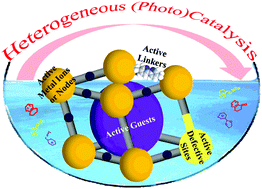当前位置:
X-MOL 学术
›
Chem. Soc. Rev.
›
论文详情
Our official English website, www.x-mol.net, welcomes your
feedback! (Note: you will need to create a separate account there.)
Catalysis and photocatalysis by metal organic frameworks
Chemical Society Reviews ( IF 40.4 ) Pub Date : 2018-07-13 00:00:00 , DOI: 10.1039/c8cs00256h Amarajothi Dhakshinamoorthy 1, 2, 3, 4 , Zhaohui Li 5, 6, 7, 8, 9 , Hermenegildo Garcia 10, 11, 12, 13, 14
Chemical Society Reviews ( IF 40.4 ) Pub Date : 2018-07-13 00:00:00 , DOI: 10.1039/c8cs00256h Amarajothi Dhakshinamoorthy 1, 2, 3, 4 , Zhaohui Li 5, 6, 7, 8, 9 , Hermenegildo Garcia 10, 11, 12, 13, 14
Affiliation

|
Metal organic frameworks (MOFs) are a class of porous crystalline materials that feature a series of unique properties, such as large surface area and porosity, high content of transition metals, and possibility to be designed and modified after synthesis, that make these solids especially suitable as heterogeneous catalysts. The active sites can be coordinatively unsaturated metal ions, substituents at the organic linkers or guest species located inside the pores. The defects on the structure also create these open sites. The present review summarizes the current state of the art in the use of MOFs as solid catalysts according to the type of site, making special emphasis on the more recent strategies to increase the population of these active sites and tuning their activity, either by adapting the synthesis conditions or by post-synthetic modification. This review highlights those reports illustrating the synergy derived from the presence of more than one of these types of sites, leading to activation of a substrate by more than one site or to the simultaneous activation of different substrates by complementary sites. This synergy is frequently the main reason for the higher catalytic activity of MOFs compared to homogeneous catalysts or other alternative solid materials. Besides dark reactions, this review also summarizes the use of MOFs as photocatalysts emphasizing the uniqueness of these materials regarding adaptation of the linkers as light absorbers and metal exchange at the nodes to enhance photoinduced electron transfer, in comparison with conventional inorganic photocatalysts. This versatility and flexibility that is offered by MOFs to optimize their visible light photocatalytic activity explains the current interest in exploiting these materials for novel photocatalytic reactions, including hydrogen evolution and photocatalytic CO2 reduction.
中文翻译:

金属有机骨架的催化和光催化
金属有机骨架(MOF)是一类多孔晶体材料,具有一系列独特的特性,例如较大的表面积和孔隙率,高含量的过渡金属以及合成后可能进行设计和改性的能力,这些特性使这些固体特别适合用作非均相催化剂。活性部位可以是配位不饱和金属离子,有机连接基上的取代基或位于孔内的客体。结构上的缺陷也会产生这些空位。本综述根据位点的类型总结了使用MOF作为固体催化剂的最新技术,特别着重于增加这些活性位点的数量并调节其活性的最新策略,通过调整合成条件或通过后合成修饰。这篇综述着重介绍了这些报告,这些报告说明了协同作用源自这些类型位点中不止一种的存在,从而导致一个以上位点激活底物或互补位点同时激活不同底物。与均相催化剂或其他替代性固体材料相比,这种协同作用通常是MOF催化活性更高的主要原因。除暗反应外,本综述还总结了MOF作为光催化剂的使用,与传统的无机光催化剂相比,强调了这些材料的独特性,涉及连接物作为光吸收剂的适应性以及节点处的金属交换以增强光诱导的电子转移。2减少。
更新日期:2018-07-13
中文翻译:

金属有机骨架的催化和光催化
金属有机骨架(MOF)是一类多孔晶体材料,具有一系列独特的特性,例如较大的表面积和孔隙率,高含量的过渡金属以及合成后可能进行设计和改性的能力,这些特性使这些固体特别适合用作非均相催化剂。活性部位可以是配位不饱和金属离子,有机连接基上的取代基或位于孔内的客体。结构上的缺陷也会产生这些空位。本综述根据位点的类型总结了使用MOF作为固体催化剂的最新技术,特别着重于增加这些活性位点的数量并调节其活性的最新策略,通过调整合成条件或通过后合成修饰。这篇综述着重介绍了这些报告,这些报告说明了协同作用源自这些类型位点中不止一种的存在,从而导致一个以上位点激活底物或互补位点同时激活不同底物。与均相催化剂或其他替代性固体材料相比,这种协同作用通常是MOF催化活性更高的主要原因。除暗反应外,本综述还总结了MOF作为光催化剂的使用,与传统的无机光催化剂相比,强调了这些材料的独特性,涉及连接物作为光吸收剂的适应性以及节点处的金属交换以增强光诱导的电子转移。2减少。











































 京公网安备 11010802027423号
京公网安备 11010802027423号